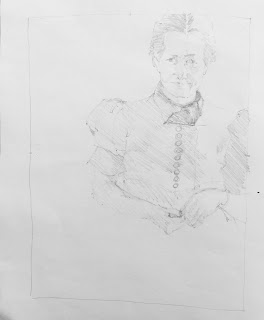A good drawing makes all the difference.
Remember hard and soft edges
Paint shapes, not objects
Stop when you think you are 90% done
Lay a light wash of Permanent Yellow Deep except where you want the white paper to show through
Hold your brush so that the bristles face vertically down to paint
Stop when you are 90% done
Tell yourself: this is just practice
I'm not taking my watercolor class this summer session so I'm trying to paint a watercolor each week. Sometimes I paint a lot in one day, sometimes just a little. I have tried to slow myself down so that I only paint while I feel confident. As soon as I start to feel squirrelly and unsure, I stop and take a breather.
My watercolors are not exhibition-worthy yet, but they are instructive for me and maybe for you. What I've learned about watercolor: a good drawing makes all the difference. If the drawing is out of proportion or off in any other way, the painting will be too. And there is little that can be done to correct that once I start painting. Might as well start over with a better drawing.
The photo of a woman from the 1930s (an old girlfriend of my dad's) intrigued me because of the high contrast. My drawing didn't show its errors until I started painting. I drew her head a little too big for the rest of her body, which only showed once I started painting below her head.
 |

Once I've done my drawing, I dampen the paper and brush a light wash of yellow. I left the white highlights on her face and arm. The wash gives the paper and subsequent washes a glow that wouldn't be there from just the white paper itself.

Learning to draw for painting means learning to leave a lighter line where soft edges will be. If I don't paint soft edges, then the painting looks flat. In this painting, soft edges can be seen in the folds of her dress, and the bottom of her arms. They can be achieved by blurring the line between one color and another or having the same value next to each other so that the two shapes blend together.

I discovered that painting with my brush held vertically with the tip towards the bottom of the paper to be an effective way to add color either in large washes or in places where I could get too concerned with detail. I have been surprised by how well it works.
Every time I start a painting, I tell myself that this is just practice. It's a way for me to relax and not to care too much. Now I'm trying to tell myself to stop when I think I'm 90% finished. It's that last 10% where I can ruin a painting by overworking an area. Than that painting goes into my pile to be cut up and used as part of my mixed media stash.
This one is just practice!

**********
My mixed media piece, There Is Always More, can be viewed online for the annual The Second Half show at the Las Laguna Gallery in La Laguna Beach, California. The exhibit is online only and has a bountiful group of work to view.
https://www.laslagunagallery.com/current



I love learning about your technique and seeing it evident in your work. Fascinating! And I like your 90% mantra; letting go at the right time works well in so many endeavors.
ReplyDeleteThank you, Teresa. I'm glad you learned something from my attempts at watercolor. I agree the 90% mantra is applicable to many experiences.
DeleteFrom Mary by email: You can certainly feel the teacher come out in you in this last weeks' blog. I think you chose the perfect profession. Thanks for sharing your insights. I am just amazed at how complicated watercolor is, even your practice pieces look wonderful.
ReplyDeletethank you, Mary. Teaching is imbedded in me.
DeleteI meant embedded.
DeleteFrom Jane on FB: Really beautiful work and thoughts Martha. I love watching your watercolor talents expand and grow!
ReplyDeleteThank you, Jane. I appreciate your reading this blog in this crazy time we are living in.
DeleteFrom Terri on FB: I learned a lot from your post. You are truly an artist. ❤️
ReplyDeleteFrom Lori on FB: I love your watercolors, Martha.
Thank you, Terri and Lori. I'm so glad you continue to read my blog!
Delete